Aerosoft Bronco X Operating Instructions
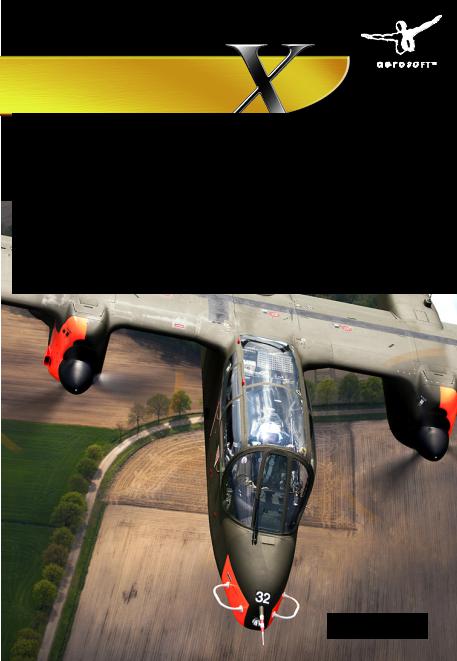
Add-on for Microsoft
Flight Simulator
Bronco
Manual

Bronco X
Concept |
Mathijs Kok (Aerosoft) |
Models/Textures: |
Stefan Hoffman (Aerosoft) |
XML/ gauges: |
Finn Jacobsen (Aerosoft) / |
|
Frank Wiesmann (Aerosoft) |
Flight mechanics: |
John Cagle |
Project Management: |
Mathijs Kok (Aerosoft) |
Manual, documentation: |
Finn Jacobsen (Aerosoft), |
|
Mathijs Kok (Aerosoft) |
Sounds: |
William Lennox (Aerosoft) |
Images: |
Nick Churchill |
Installer: |
Andreas Mügge (Aerosoft) |
Testing: |
Several good folks who will |
|
all be getting a free copy |
A special thanks to the OV-10 Bronco Association, German Wing, very cool people (Tony DeBruyn, Thomas Viertbauer, Tom Houquet, Michael Vaeremans, Peter Junior, Heinz-Dieter Rheinländer, Ela Gedl, Markus Rheinländer) who fly a very cool aircraft. Without their help this aircraft would not be half as good.
Copyright: © 2012/ Aerosoft GmbH
Airport Paderborn/Lippstadt
D-33142 Bueren, Germany
Tel: +49 (0) 29 55 / 76 03-10
Fax: +49 (0) 29 55 / 76 03-33
E-Mail: info@aerosoft.de
Internet: www.aerosoft.de
www.aerosoft.com
All trademarks and brand names are trademarks or registered of their respective owners. All rights reserved.
2
Aerosoft GmbH 2012

BroncoX
Manual
Add-on for
Microsoft Flight Simulator X
3

Bronco X
Content
Introduction................................................................ |
6 |
System Requirements.......................................................... |
7 |
Contact Support................................................................... |
8 |
Specifications(OV-10A)........................................................ |
9 |
FSX Limitations and Settings............................................. |
10 |
Flying the Bronco..................................................... |
13 |
||
The Garrett Turboprop Engine.......................................... |
16 |
||
Failures...................................................................... |
18 |
||
Accumulative Engine Wear........................................ |
19 |
||
Electrical System................................................................. |
22 |
||
Battery Busses............................................................ |
22 |
||
Engineer Station Gauge............................................. |
24 |
||
Fuel System......................................................................... |
26 |
||
Hydraulic Power System.................................................... |
27 |
||
Oil System........................................................................... |
27 |
||
Power Levers/ Condition Levers....................................... |
28 |
||
Landing Gear...................................................................... |
29 |
||
Nosewheel Steering................................................... |
29 |
||
Wheelbrakes/ Parking Brakes..................................... |
29 |
||
Flight Control Systems....................................................... |
30 |
||
Trims.......................................................................... |
30 |
||
Wing Flaps................................................................. |
30 |
||
Aerosoft GPS Unit.............................................................. |
31 |
||
Map Mode................................................................ |
31 |
||
Direct To Mode.......................................................... |
32 |
||
Cursor Mode............................................................. |
33 |
||
HSI Page.................................................................... |
35 |
||
Becker BXP 6401 Transponder........................................... |
38 |
||
Tacan Receiver.................................................................... |
40 |
||
Becker AR 4201 |
|
||
Communication Radio........................................................ |
41 |
||
Interactive Checklist Gauge............................................... |
42 |
||
Panels.................................................................................. |
46 |
||
|
4 |
|
|
|
|
|
|
Aerosoft GmbH 2012

Main Panel.......................................................................... |
47 |
Right Side Main Panel........................................................ |
48 |
Left Rear Side Panel........................................................... |
49 |
Left Forward Side Panel..................................................... |
51 |
Throttle Quadrat................................................................ |
52 |
Overhead Panel.................................................................. |
53 |
Right Forward Side Panel.................................................. |
54 |
Right Rear Side Panel......................................................... |
55 |
Right Sidewall Switches.................................................... |
56 |
Checklist.............................................................................. |
57 |
Normal Checklist........................................................ |
57 |
EMERGENCY CHECKLIST........................................... |
68 |
Appendix A: Landing Pattern............................................ |
79 |
Appendix B: The Making Of.............................................. |
80 |
5

Bronco X
Introduction
Almost all aircraft designed for a COIN (counter-insurgency) are great fun to fly. They have to be sturdy and have loads of power to get out of trouble and they also have got to be agile and easy to fly low to the ground. So they are all the opposite of airliners that draw straight lines high in the sky, they feel most at ease when the hug the ground and pull G. The OV-10 Bronco is perhaps the finest example of this class of aircraft.
The Bronco has its roots deep in the 1960s when most military aircraft were getting bigger, more complex and way faster. These aircraft did not work well in harsh conditions found in jungles and even on carrier decks. The concept of a rugged close air support aircraft that would be ideal to operate in limited scale conflicts and operate from improvised airfields was proven by the Cambodia and Vietnam conflicts that were developing at the time. The North American (later Rockwell) developed the concept into prototypes that were soon in service with the U.S. Marines Corps, U.S. Air Force and the U.S. Navy. In Vietnam the aircraft was introduced in a Forward Air Control role, guiding large attack aircraft onto targets but soon the Bronco’s went into battle with a large array of ground attack weapons. Medium bombs, rocket and gun pods all proven to be effective and even Sidewinders against air targets were used. To increase loiter time over ‘Indian’ country external fuel tanks were added. All this additional weight and drag caused the aircraft to feel underpowered, even though it has ample power when it is flown without external stores.
The Bronco has a small fuselage but if comfort was not important and the backseat removed it could carry 5 passengers. In fact the Bronco was soon used in every possible role. It was one of those aircraft that seemed to grow in potential over time, and as can be seen with other aircraft (the A10 Warthog for example) it seems hard to find a modern replacement. That’s why there are still plans to build a updated version using the same basic design. When the Bronco was pulled from front line duty it was still in demand in military and civil roles.
6
Aerosoft GmbH 2012

Countries like Colombia, Indonesia, Philippines, Thailand, Venezuela, Lebanon and Germany used them for many tasks including drug interdiction, firefighting and target tugs. Many are still flying and they are welcome guests at airshows with their distinct shape and sound.
Our standard version is based on the OV-10B that was last in service in Germany as a target tug (dragging air targets for other fighters) and now fly as part of the German Wing of the OV10 Bronco Association (GWOBA). That organization and especially its founder Tony De Bruyn and press Officer Markus Rheinländer cannot be thanked enough. Do visit their website at http://www.germanwing.de/Start.htm.
System Requirements
•Windows XP, Vista, 7 (fully updated)
•Microsoft Flight Simulator FSX (with SP2 or Acceleration Pack)
•Dual Core CPU
•2 GB RAM internal memory
•512 MB graphic card
•Adobe Acrobat® Reader 8 minimal to read and print the manual (1)
(1)Available for free, download at: http://www.adobe.com/prodindex/ acrobat/readstep.html
7

Bronco X
Contact Support
Support for this product is offered by Aerosoft. We prefer to have a support forum for the simple reason that it is fast and efficient because customers help customers when we are sleeping.
There are special forums for this product at: http://forum.aerosoft. com/index.php/forum/474-ov10-bronco/
We feel strongly about support. Buying one of our products gives you the right to waste our time with questions you feel might be silly. They are not.
Versions
The Broncos came in various variants:
•OV-10A - Original production version
•OV-10B - German broncos used as target tugs (the Aerosoft Bronco cockpit is based on this version)
•OV-10C – Export version for Thailand
•OV-10E – Export version for Venezuela
•OV-10F – Export version for Indonesia
•OV-10D – Second generation Bronco with modernized systems
8
Aerosoft GmbH 2012

Specifications(OV-10A)
Crew: |
2 |
Length: |
41 ft 7 in (12.67 m) |
Wingspan: |
40 ft 0 in (12.19 m) |
Height: |
15 ft 2 in (4.62 m) |
Wing area: |
290.95 ft² (27.03 m²) |
Empty weight: |
6,893 lb (3,127 kg) |
Max takeoff weight: |
14,444 lb (6,552 kg) |
Powerplant: |
2 × Garrett T76-G-410/412 turboprop, |
|
715 hp (533 kW) each |
Performance |
|
Maximum speed: |
281 mph (452 km/h) |
Range: |
576 mi (927 km) |
Service ceiling: |
24,000 ft (7,315 m) even though |
|
18.000 ft seemed always more accurate |
Armament |
|
Guns: |
4 × 7.62x51mm M60C machine guns |
Hard points: |
5 fuselage and 2 under wing and |
|
provisions to carry combinations of: |
Rockets: |
7- or 19-tube launchers for 2.75” FFARs or |
|
2- or 4-tube launchers for 5” FFARs |
Missiles: |
AIM-9 Sidewinder (Wing pylons only) |
Bombs: |
Up to 500 lb |
Other: |
SUU-11/A or Mk 4 Mod 0 gun pods |
9
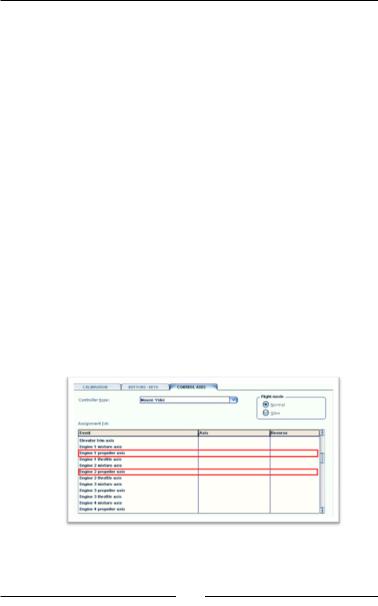
Bronco X
FSX Limitations and Settings
Unfortunately FSX has some limitations that are hard to overcome, it also has some bugs that that are simply not possible to avoid. Some limitations (like Landing Lights and the complete Electrical System) have been circumvented by replacing what FSX has to offer and writing our own code, but some other things are not so easy. We like to mention them.
Almost all lights are not very solid in FSX. They always seem to wander around the airframe. Even stranger, this effect depends on where you are on the globe. We have avoided this effect in some cases by not using effects but modeled ‘balls’ of light. These are not easy to see at long distances but look better close up.
The sound is a special problematic area for this project because FSX does not know this type of engine. When we would have used the standard turboprop sound the startup would be rather unrealistic as the propellers would be heard while they would not be moving. So we are using a combination of FSX sounds and some played by our own sound module. We even switch off the default FSX sound during start-up otherwise it would be even more problematic. So don’t worry if you see the SOUND OFF message appear for a moment.
10
Aerosoft GmbH 2012
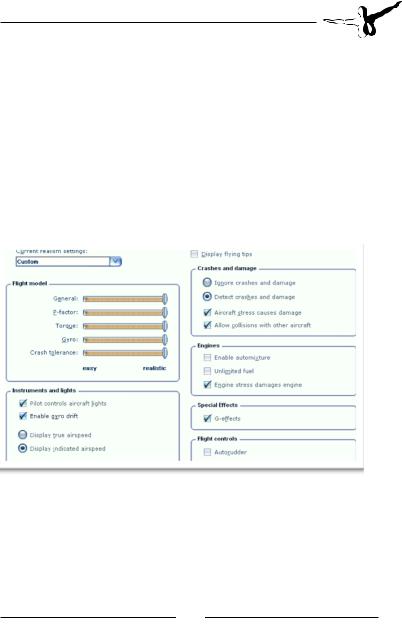
The OV-10 Bronco does use special coding to handle the props and the Engine 1 propeller axis and Engine 2 propeller axis should be left unassigned in FSX. If you do have hardware assigned on those axis leave the levers fully forward when using the Bronco.
We decided not to model the back seat as it really is useless in FSX. You can’t fly the aircraft from there as visibility is almost zero. Note that the aircraft is now mostly flown with just the pilot. The Bronco does not have an Autopilot but we left the standard FSX Autopilot key commands on so when you do need to make a long flight you can use it. We strongly recommend FSX REALISM settings as shown in the image. If you prefer to fly without rudder activating the Autorudder is an acceptable option.
Because this aircraft is modeled with detailed system using a nonstandard startup situation could cause some systems to be in an incorrect initialization state. We provided a startup situation called Aerosoft - OV10 Bronco that places the aircraft at the airport where it is normally found (Wevelgem Belgium) with all FSX settings as they should be. Feel free to change the weather and location but do not change any of the other settings.
11

Bronco X
To handle some of the more complex systems we need to overwrite certain parameters in FSX. This causes the standard select engine and select doors commands to be less reliable. We added a small panel that can be called up with [SHIFT] + [4] that makes these functions easy to access.
The Bronco does not have a standard spoiler system so we took advantage of this to include an invisible spoiler that makes ground maneuvering and STALL landings far more realistic. If you notice that you are not able to reach sufficient speed in flight (at least 200 knots without any problem) check if there is you have the spoiler assignment handled by FSUIPC or have it linked to a hardware button. In the air the code will set the spoilers to retracted a few times every second.
12
Aerosoft GmbH 2012

Flying the Bronco
You will find that the Bronco is an amazingly easy aircraft to fly; it has almost no nasty features you should be aware of. There are however a few things that are special. For starters the very wide speed range, it has been clocked at 400 knots (okay that is over the 350 knots red limit and in a dive) and with full flaps it will land at 44 knots (!) without problems. It will basically feel very happy at any speed between 100 and 300 knots. If you consider the role of the aircraft it makes sense. It needs to get somewhere fast and then loiter for as long as possible. That loitering was often done at low altitudes and between the trees and hills where the aircraft seems to be happy. As long as you keep in mind the engines need a bit of time to spool up (and the aircraft is not loaded up with weapons) you will have ample power to get out of tricky situation.
The German OV10 Bronco we used as our base model flies at many airshows and it used to fly this demo in 2010:
1.Take off360° climb
2.High speed pass followed by a 45° steep climb
3.Slow speed pass with landing gear down
4.Top side pass
5.Horizontal 360° turn
6.Bottom pass
7.Wing waggle
8.Stoll Landing
13

Bronco X
Don’t be afraid to pull some G in the Bronco, it loves tight turns. It also loves steep dives. As one Bronco driver told us:
“…very much a pilot’s aircraft. Named after a type of horse and that makes a lot of sense. You sit in it like you sit on a horse, in a very high seating position with great visibility all around and it seems to understand what you want to do. A good Bronco driver can put her anywhere he likes in any attitude. It’s a shame they are getting old now and the pilots have now got more sense than we did. We pulled stuff you will never see at airshows now and most of my friends landed after all that. If you lose an engine though, better be prepared to bail out because things get out of hand real fast.“
Tony de Bruyn, who has to be one of the current Bronco pilots with the most experience, sent us this when we asked about what it is like to fly this aircraft:
“Flying the Bronco is like feeling to be on top of the world, such is the fantastic view all around, the responsiveness on the controls, the speed range and its versatility. There seem to be no limits in where you want the aircraft to take you and it does it in such a way that you are continuously wondering whether the airplane is reading your mind rather than you making control inputs. It flies with such magnificent ease that one soon feels very privileged in handling the thoroughbred and bring the very best out. Some additional personal comments/ thoughts. The people at NAA were probably at the pinnacle of airplane development at the time when the Bronco was conceived in the mid 1960’s:
•The engineering is out right brilliant - no doubt building on a long and highly successful legacy (just to name a few: AT6 Texan, P51 Mustang, B25 Mitchell, F86 Sabre, X15, etc...)
•The flying characteristics are just magnificent; unbelievably well harmonized and light controls throughout the full speed range from 70 to 350 KIAS (note: KIAS), very direct and snappy response to control inputs make it very well liked by everyone who ever got their hands on it.
14
Aerosoft GmbH 2012

•Operationally the Bronco is incredibly versatile feeling at home in and out of any environment - jungle to dessert, unprepared dirt strips, carrier deck, you name it, it has been there...
•Maintainability; it was designed to be maintained out in the field with just a standard tool set at hand, no special tools are required.
•Even when it came to giving the airplane a name, they absolutely got it right: bronco: A wild or half-tamed horse, esp. of the western U.S. From Spanish, literally ‘rough, rude.’ The Bronco is not too large, just as the wild horses out on the prairies. It’s got a little way of it’s own, but in a good natured way; you will need to keep it in control - tame it - all the time but this is easily done.
•It’s got a purposeful rough appearance, some say it’s beautiful others think differently. It definitely has got CHARACTER and it shows!
A very likable airplane altogether and I have never come across anyone who has expressed any dislike or displeasure about the OV10 Bronco, which is probably also unique and a good indication of its quality.”
If you want to get an idea how the Bronco should be flown, check out this video: http://player.vimeo.com/video/28244509. It shows the Bronco in its element, flying low and fast, twisting and turning.
What ever you do, don’t be hung up on charts and speeds. The Bronco will tell you when it is about to stall (keep an eye on the airspeed indicator, before the stall happens the buffeting airstream will make it jitter) and when it wants to fly. One mistake however that is easy to make is to lose too much speed at landing, although you can fly at very low speeds it is strongly advised to stay over 100 knots. See the landing chart that is added at appendix A. Also listen to the aircraft, you hear the airframe groan when you put G-load on it, the wind noise will give you good indications on the speed.
15

Bronco X
The Garrett Turboprop Engine
The turboprop model in FSX is poorly modeled, the same is true for torque and EGT readouts from FSX. Air-starting the engines by wind milling is not featured by FSX, but through coding around the FSX “engine”, we managed to correct all these deficiencies.
The turboprop available in FSX is based on the Pratt and Whitney PT6 type of engines. The PT6 is a free turbine engine. This means that the core engine - the gas producer is a self-sustained gas turbine. The propeller is driven through a gearbox connected to a separate turbine placed after the gas producer. This means that the gas producer is allowed to start and spool up independently of the propeller and it´s turbine. Since propeller blade pitch angle is controlled via a hydraulic governor, which uses engine oil pressure, the propeller will move into feathered position when engine oil pressure is lost or if the condition lever is moved fully back into the SHUTDOWN and FEATHER position. A feathered propeller needs a huge amount of torque to overcome the drag when spinning. Since a free turbine turboprop allows the gas producer to spool up without turning the prop, sufficient engine oil pressure will build up to un-feather the propeller.
The turboprop engines used on the Rockwell OV-10A Bronco are the Garret T-76 types of engines. They are known as single shaft geared turboprop, in which there is no separate turbine for the propeller. This means that the propeller is directly linked to the gas producer via the gearbox. With a feathered propeller, the engine starter will have to both turn the gas producer as well as the propeller up to speed during start up. As explained, a feathered propeller needs a lot of torque to overcome the drag induced when the propeller starts spinning. This is not desirable. To prevent this, a mechanism called Start latches are built into the propeller. The start latches locks the propeller blades in their beta range so with flat pitch position (between full fine and reverse). In that position the propeller blades produce very little drag, but also no forward thrust - or at least very little.
16
Aerosoft GmbH 2012

To engage the start latches, the pilot needs to pull the throttles into the reverse range right after shutdown of the engines but before Ng RPM drops below approximately 50%. This will keep the propeller blades in the beta range enabling the start latches to “snap in” and lock the blades. To disengage the start latches, the pilot only need to move the throttle into reverse range after engine startup has occurred and Ng RPM is above approximately 60%. Throttling up with start latches engaged will be noticed because of the lack of forward thrust and little torque readout on the gauges.
In the case where the pilot fails to move the throttles into reverse range, the propeller will feather, just like on the free turbine types of engine. In such cases the propellers will need to be un-feathered. This is done via the Airstart switches. The airstart switches have 3 positions CRANK, AUTO, ON. AUTO is the normal position and will automatically control fuel and ignition in accordance to the engine RPM sensing switches. CRANK will turn on a pump called the un-feather pump. This pump supplies oil pressure to the propeller governor forcing the propeller blades towards full fine and beta range - no fuel or ignition is introduced. Crank is somewhat misleading - it won´t crank the engine by the Starter, but merely points to the fact that in air, the un-feather- ing of the propeller will cause these to start wind-milling. ON means that the un-feather pump as well as fuel and ignition is introduced for an air-start. After un-feathering / air-start the Airstart switch must be returned to AUTO. Note the Bronco has two additional ignition switches for continuous ignition.
The description might sound complex, but is actually very straight forward. For starting the engines on the Bronco follow this procedure:
• Power levers: GROUND IDLE
•Condition levers: SHUT OFF (NOT SHUT OFF & FEATHER)
•Primary DC bus: POWERED (BATT DISC & BATT MAIN
SWITCHES ON OR GRND PWR ON)
17

Bronco X
If propellers not feathered:
• Start switch: |
ON |
•At 10% Ng RPM : CONDITION LEVER NORMAL FLIGHT
If propellers feathered: |
|
|
• |
Power levers: |
MOVE INTO REVERSE RANGE |
• |
Airstart switch: |
CRANK |
•Prop at flat pitch set
|
Airstart switch: |
AUTO |
• |
Power Levers: |
GROUND IDLE |
• |
Start switch: |
ON |
• At 10% Ng RPM: |
CONDITION LEVER |
|
|
|
NORMAL FLIGHT |
Failures
The engines in the Aerosoft OV-10 Bronco will fail if they are not treated with respect. They are very well maintained but they are a few decades old, so be nice to them. All failures can be switched off in the checklist configurator.
•Engine flameouts might occur when flying in icing conditions without having switched on the continuous ignition switches.
•Starter motors will fail if run too long with feathered propellers due to over torque.
•Continuous torque should be limited to 1875 foot/lb and only exceeded for short amounts of time. When this limit is exceeded the chance of a failure increases dramatically. Keep in mind the overtorque warning light will only be lit at 2200 foot/ lb so do not wait for them to light up.
18
Aerosoft GmbH 2012

•Another source for engine failure is overheating. To monitor engine temperatures there is a EGT gauge for each engine. During startup they show EGT (Exhaust Gas Temperature), but when Ng (RPM) passes 50% they shift to read TIT (Turbine Inlet Temperature). EGT is measured with a probe in the exhaust gas, while TIT is calculated from EGT, since no probe would last very long at the TIT temperature. The TIT is further altered by the SRL computer (Single Red-Line) also called the “Pilot Lier”, since the temperature shown is different from the real TIT. Under ISA conditions the T76 engines are limited by torque until approximately 17.000 feet where Max Allowable EGT normally is reached). With higher OAT this altitude becomes lower. To be honest, the Bronco is not happy when flown that high, it’s an aircraft designed to be flown low. Max Allowable EGT is not a fixed value, but is a function of Ng (RPM), OAT, Altitude and Airspeed. Using EGT to determine if you are running the right temperatures is complex and involves many tables and charts. That’s where TIT with the SRL correction comes is, Max allowable TIT, compensated by the SRL, is always approximately 1000 °C , so the pilot only needs to verify that the needles don´t get higher than that. The TIT Warn lights are also set to light at 996 °C. Some Broncos (the German OV-10B’s for example) were later changed to always display EGT, but still have the TIT warn lights that will light when the temperatures are too high. Keep an eye on these lights. They are important.
Accumulative Engine Wear
If this option is enabled the engines will start to wear. They will degrade over time by this schedule:
• |
0-80 hours |
= Excellent |
||
• |
80-120 hours |
= Good |
||
• |
120-140 hours |
= Ok |
||
• |
140-160 hours |
= Poor |
||
• |
160 -> hours |
= INOP (not functional) |
||
|
|
|
|
|
|
|
|
19 |
|
|
|
|
|
|
|
|
|
|
|
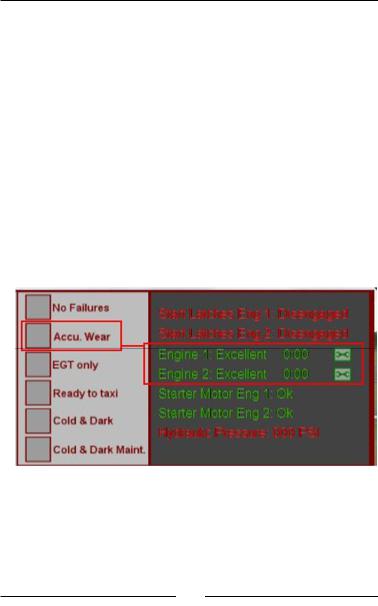
Bronco X
This schedule only holds true if the engines are operated within their limits. This means that the engines won´t be over torqued or overheated! If they are being run outside their limits the degradation happens faster as a function of how much and how long they have been run above their limits. With increased degradation the engines will start to run hotter over time until INOP state is reached, then they will stop running and cannot be started.
The real Bronco has a time between overhaul at 1600 hours (Some even extended to 3400 hours). Since no flightsimmer ever well reach that figure this time has been reduced to 1/10 of this i.e 160 hours. This is still a lot of flight simming time, and since degradation happens exponentially you won´t see any change before reaching 80 hours.
For those who want to speed up degradation further the option has been added to decrease this time even further by selecting 2x or 4x this rate. This option is disabled by default. To enable – click to cycle between disabled, 1x, 2x & 4x.
On the above figure the selection box labelled “Accu. Wear” can be seen. It is disabled. Engine health state can be seen to the right together with their operating time Hours:Minutes. Clicking on the small “Wrench” symbol for each engine will overhaul it and reset the timer. The Wrench symbol will also repair the engine(s) if they have failed and reset the fire extinguishing system for the affected engine.
20
Aerosoft GmbH 2012
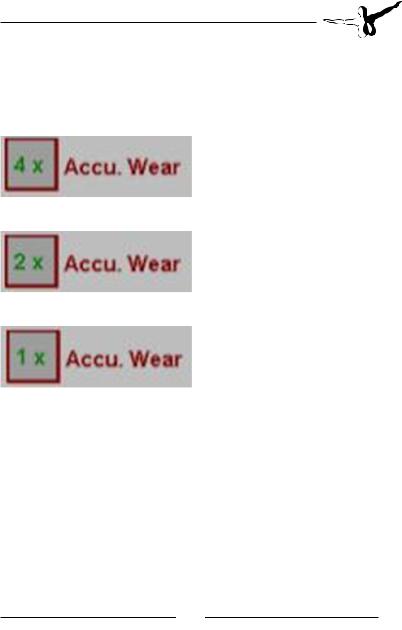
When the “No failures” checkbox is checked the engines will not stop running and can still be started, but the EGT gauge will still show the increased operating temperature due to degradation. When clicking the “Accu. Wear” checkbox the following symbols will appear instead of a checkmark:
Symbol for normal wear (0-160 hours)
Symbol for 2x wear (0-80 hours)
Symbol for 4x wear (0-40 hours)
When you use the engines correctly you should be able to reach the 160 (or 80 or 40) hours without much problems. Your mechanics will love you.
21

Bronco X
Electrical System
One of the most important systems of an aircraft is the electrical system as most parts of an aircraft rely on electrical supply, such as fuel pumps, hydraulic pump, engine controllers, various instruments and radios as well as lighting. The electrical system has faithfully been simulated in the Aerosoft OV-10 Bronco. The default FSX electrical system has been scrapped and replaced by our custom coded system. Everything that depends on electricity, down to the smallest light bulb, will add a load to the system.
The main type of electrical power supply on the Bronco is 24VDC. This is supplied from the two batteries, the two generators or ground power. The generators also act as engine starter motors. To manage the power distribution, the electrical system is divided into several busses (busbars). This is also done to preserve electrical power in the event of generator failures. For example the secondary bus, supplying non-essential systems as lights and radios will be turned off if both generators fail. The generators, which also act as starter motors, and can fail if not used right.
Some equipment requires 115VAC. This is made available by converting 24VDC into 115VAC through the inverters. The Bronco has two inverters, one primary and a backup inverter. Both are powered under normal conditions though.
Battery Busses
Primary DC bus 24 VDC:
•Start ignition advisory light
•Engine fire warn sys
•Fuel boost pumps
•Hydraulic pump
•Gear / Flap indicator
•Alternate flaps
•Unfeather pumps
•Pitot heat
•Windshield wiper
22
Aerosoft GmbH 2012

•Smoke generator
•Trim motors
•Trim indicator
•Warn and caution lights
•Turn and Slip indicator
Start Control DC bus 24 VDC:
•Engine 1 Utilities
•Engine 2 Utilities
•Engine 1 Starter
•Engine 2 Starter
•Engine 1 ignition
•Engine 2 ignition
•Fuel shutoff valves
Secondary DC bus 24 VDC:
•Landing lights
•Taxi lights
•Formation lights
•Position lights
•Anti-collision lights
•Panel lights
•Communication radio
•Nav radio
•ADF radio
•Transponder
Monitored DC bus 24 VDC:
•Yaw damper
Primary AC bus 115 VAC:
•Attitude indicator
•Standby Attitude indicator
•Fuel quantity indicator
•Engine 1 EGT indicator
•Engine 2 EGT indicator
23

Bronco X
Monitored AC 1 bus 115 VAC:
•TACAN
•Strike camera
Monitored AC 2 bus 115 VAC:
•TACAN (Alt pwr)
Instrument AC bus 26 VAC:
•VOR/ILS indicator
•Directional Gyro/VOR/ADF ind.
•Marker beacon
•Engine 1 torque indicator
•Engine 2 torque indicator
•Oil pressure indicator
Engineer Station Gauge
During the development of the Bronco it was hard to understand exactly how the system interacted so the systems coder Finn decided to make a simple schematic instrument that shows how it works. We have gotten so used to it we decided to keep it in the released code. We even decided not to make it look refined so you get an idea of how we code these complex systems. You can open it with [SHIFT]-[3] and when you move your mouse over the switches and busses you will see where you can click. Most switches can be operated (sometimes with left and right mouse buttons) and when you click on a bus (vertical thick red line) you will see what’s connected to it. When a bus or supply “string” is unpowered it is blue, while being red when powered. Actual voltage and ampere load can be read for each bus as well as batteries and generators.The best way to see it in action is to open it, select Cold & Dark and then select ready to taxi. The aircraft will go through the whole startup sequence and you see the generators and busses come online. When all is running, start disconnecting things and see how the systems are affected. The real Bronco drivers would have loved something like this!
24
Aerosoft GmbH 2012

In the upper right corner various engine related items can be checked for their state. There are also checkboxes for setting aircraft state and user preferences like found in the Interactive Checklist gauge. When clicking on the various bus bars a list with the equipment that it supplies will be shown as long as the mouse button is pressed.
25
